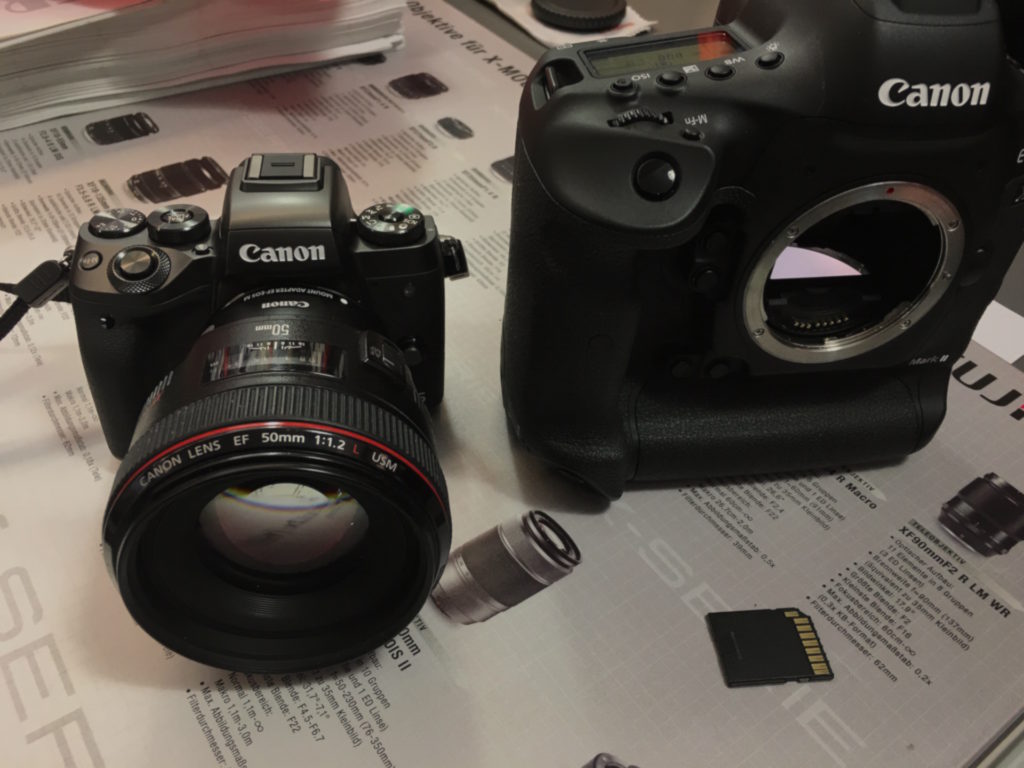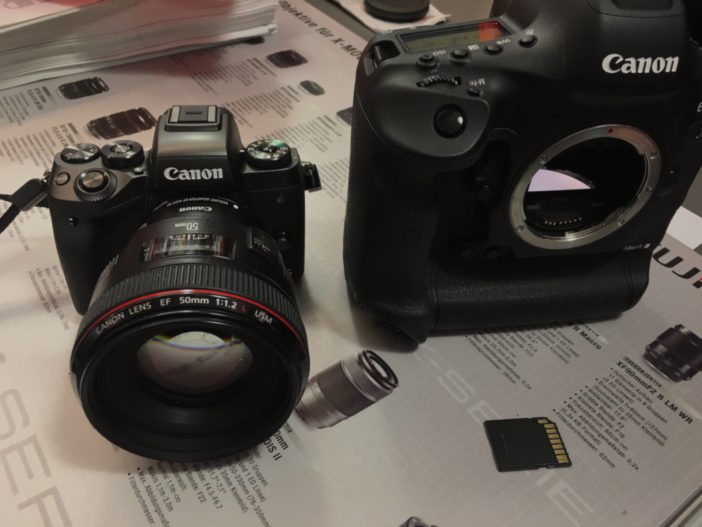
I’ve been considering the Panasonic FZ2500, and have also tried out the long awaited EOS M5 that nobody was particularly waiting for.
As the consumer market exits the warm swimming pool into the cold air of winter, all that shrinkage has resulted in some changes.
Camera manufacturers have decided to add value, which is business speak for hiking prices.
Examples abound. Panasonic have upgraded the FZ1000 to the point where it now resembles a semi-pro camcorder in the FZ2500. Sigma have released a range of heavily breathing not quite par-focal cinema lenses. And Canon have decided to court enthusiasts with the EOS M range.
Canon EOS M5
Whereas the original Sony RX100 and Sony A6000 started life as affordable consumer cameras punching way above their weight in terms of specs, the EOS M started life as an affordable consumer camera.
The EOS M5 has evolved into an expensive consumer camera.
Is it an enthusiast mirrorless camera? It’s hard to get enthusiastic about moire and aliasing, 1080p and a memory card slot in the battery compartment, in 2016.
The EOS M5 serves one purpose – a cute EVF for your large EF lenses.
The native EOS M lens range is pathetic.
The small size advantage of the body compared to the 80D is nothing as soon as you attach pretty much any decent optic.
There’s no Speed Booster for full frame lenses, unlike for the Sony A6500 and no 5 axis in-body stabilisation. I don’t even need to mention the lack of 4K. It’s a Canon!
Dual Pixel AF works well, but you may as well get the 70D, install Magic Lantern and shoot RAW video with Dual Pixel AF.
The EOS M5 body-only costs 1200 euros in Europe, which for me is a bit silly when you can get the 4K shooting Panasonic G85 body with 5 axis stabilisation and a massive native lens range for 800 euros body-only or a A6300 for 1000 euros. The EOS M5 comes with an EF mount adapter, presumably because Canon knows how embarrassingly bad their mirrorless lens range is.
The EOS M5 handles a bit like a Powershot camera, and the ergonomics don’t have anything particularly wrong with them, but it all feels a bit dumbed down, a bit underpowered, a bit toy-like.
Photographers can spend the same money and get a brand new full frame Nikon D610.
The EOS M5 suffers horrible aliasing and fuzzy moire in video mode. The only time the EOS M5’s image looks good is on the tiny camera’s LCD in the shop. You get the footage back and it looks properly dirty. It isn’t suitable for the enthusiast market it is aimed at.
Sony RX100 V
The most exciting cameras in the RX100 range have been the first and the forth. The II and V were too incremental and not interesting enough as updates to what went before. The III was somewhere in-between with the cool pop-up EVF.
The RX100 V’s foremost new feature is the improved phase-detect AF but it doesn’t work in my favourite video mode, the continuous 1080p 120fps. I just can’t see a way to justify replacing my IV with the V. Not enough has changed.
This time Sony made sure to point out oversampling in 4K mode from the 5K sensor but this was there all along, in the Mark IV. The FOV still crops in on the various 4K and high frame rate modes but not dramatically in 4K, 1080p 120fps and 1080p 240fps. Again no change there.
The camera comes out at the same time as the A6500 but doesn’t feature the new Sony menus.
The RX100 V feels like a premium version of the RX100 IV developed at the same time around 1 and a half years ago, held back until late 2016 and punted out for a higher price.
If Sony are going to bring out very small incremental updates like this every year, I’d rather they worked on the ergonomics more than just a couple of tweaks to the specs sheet each time. The ergonomics of the RX100 series haven’t changed in 5 iterations in 4 years. I much prefer the handling of the slightly larger Panasonic LX100. Canon also do a better job with their range of high end compacts with 1″ sensors, but on those the video specs are laughable compared to Sony.
Panasonic FZ2500
The Panasonic FZ2500 goes up against the Sony RX10 III and costs double the previous one (FZ1000). The picture quality and sensor of the FZ2500 we’ve seen before in 2016 with the TZ101 and LX15. The latter appears to be a reply to Sony’s successful RX100. A rather slow reply it must be said, as the RX100 came out 4 years ago. It’s a reply which could have been written on a postcard and lost, before resurfacing and being sent to a grandmother, who passed away while waiting. Perhaps the LX15 is really an answer to the RX100 IV with all the nice stuff taken out. Any way, it is $699 and that is the same price as the superior LX100, which has a much larger sensor, a built in EVF and 4K that doesn’t crop the 24mm lens to 36mm!
The FZ2500 is $1200 or ten million euros in Europe due to, I am told, exchange rate differences, washing machine tax and the Chinese sandwich economy. Either way in real money it is about $300 more than the G85 body. Like the LX15, the FZ2500 use the OLD Sony 1″ sensor and that is a bit past it for video. This is less of a problem on the LX15 which is aimed mainly at photographers. More of a problem for the FZ2500, which is basically sold as a semi-pro camcorder! I’ve tried it out and this camera is SUCH a missed opportunity. It’s an absolutely fantastic body in every respect apart from the old sensor. Feature packed to the rafters and with great ergonomics, Panasonic could have killed the Sony RX10 III stone dead with this. But out goes the nice 1080/120fps of the RX10 III and RX100 IV with no moire, in comes mushy compromised 120fps with a ton of aliasing, out goes 240fps cache record, in comes nothing, out goes 480fps and so on until we come to 4K itself which kicks out the appeal of the 1″ sensor entirely, choosing to use a small window of it and losing your wide angle in the process.
This is a shame as the stabilisation and it has the best internal ND filter of any consumer camera on the market. Now a few years ago at $700 with the FZ1000 I was happy to overlook the shortcomings of the sensor in video mode, mainly as a better one didn’t yet exist nor did the RX100 IV and RX10 III. Now they do.
What’s more, Sony give you LOG for free on the RX10 III. On the FZ2500 it’s still a paid update.
I think the FZ2500 is Panasonic being a bit off form, but the good news is the Panasonic GX85 and G85 have been utterly superb this year and the GH5 is looking stunning on paper. Pre-orders for that camera start in January and until then I will be giving you a review of the Panasonic G85, which in many ways is a GH5 for half price, 4 months earlier.





